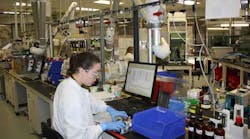One of the main tenets of lean manufacturing is that quality should be built into the manufacturing process. Life Technologies Inc.'s Austin, Texas, plant launched an initiative in 2008 aimed at making quality control part of the manufacturing process.
The plant integrated its quality control function into its production teams to improve product flow and visibility. The move helped reduce lead times at the 2011 IW Best Plants winner by removing batch quality-control tests. Life Technologies produces acid formulations used by researchers for applications in areas such as pharmaceutical testing, university labs and government research institutions.
"When the processes are separate and there's a lag of time, then you can't get the cause and effect," says Brett Petrie, senior director of manufacturing and Life Technologies global leader of operational excellence. "By taking the QC person and embedding them into the team, the product is made one day, and the next day it's tested, and you can troubleshoot very quickly because there's not a long lag time."
Previously, when the quality-control team identified a problem it would bring the issue to the manufacturing group's attention. Without quality-control integrated into the process, the quality specialists could not see what actions may have led to a particular issues, says Pamela Hansen, manufacturing manager. Hansen previously worked in quality control and moved over to manage the plant's MolBio and Solutions Prep manufacturing groups when the integration was completed.
The process change cut lead times by as much as 50% by eliminating queues of product awaiting quality-control checks, Petrie says.
"It enabled us to do some things in parallel that we weren't able to do when they were separated between the manufacturing group and the QC group because some QC testing could be started before all of the components of a particular product may have been completed," Hansen says. "But when there are separate groups we couldn't do that, so we were able to reduce turnover time because we were able to do some things in parallel."
The integration also was part of the company's plan to create self-sufficient, "high-performance work teams" that have ownership over their product lines, Petrie says. The employees are now able to identify problems themselves and take action earlier in the process.
See Also:
- Formula for a Lean Makeover: Plant transformation creates a true manufacturing environment in a science-based culture and major revenue wins.
- 2011 IW Best Plants: See the full list of winners.
- 2012 IndustryWeek's Best Plants Conference: Meet the 2011 winners in Indianapolis April 23-25.
- 2012 IW Best Plants Competition: Sign up to receive an application.



